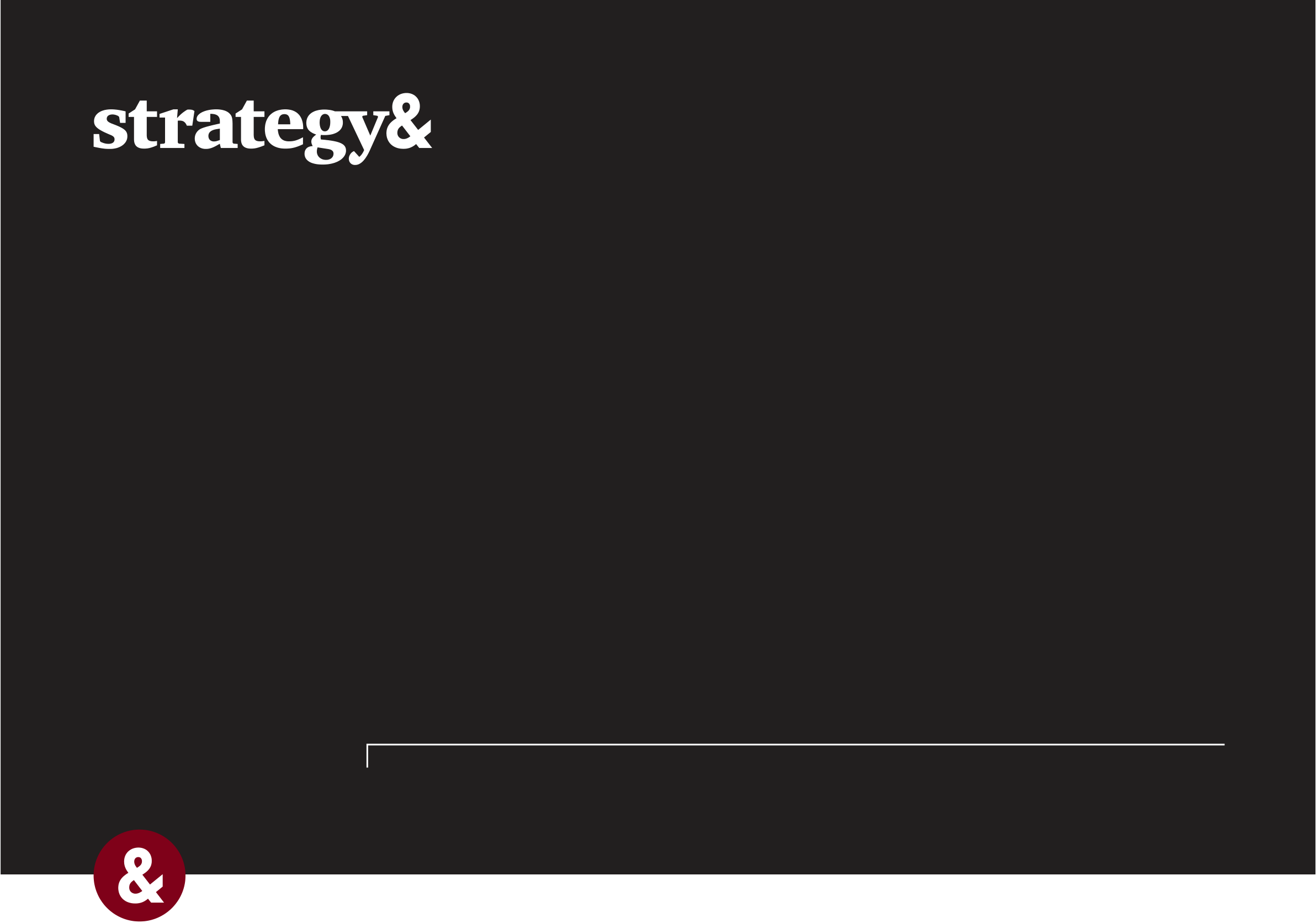And heads the pwc strategy industry team germany

Industry 4.0
|
|
|
|---|---|---|
|
|
|
|
|
|
|
|
|
|
||
|
||
|
||
|
||
|
|
|
|
||
|
||
|
||
|
||
|
|
|
|
||
|
||
|
||
|
||
| Partner, PwC Strategy& Germany | Strategy& | |
|

Executive summary
4 Strategy&
Better yet, transparency will enable companies not just to react to disruptions but to anticipate them, modeling the network, creating “what-if” scenarios, and adjusting the supply chain immediately as conditions change.
The goal of the digital supply chain is ambitious: to build an altogether new kind of supply network that’s both resilient and responsive.
6 Strategy&
At the heart of all this activity sits the digital supply chain, and it is key to the operations of every company that manufactures or distributes anything. Indeed, for many companies the supply chain is the business.
It extends the vertical integration of all corporate functions to the
horizontal dimension, knitting together relevant players — the suppliers of raw materials and parts, the production process itself, warehousers and distributors of finished products, and finally the customer — through a network of sensors and social technologies, overseen via a central control hub, and managed through an overarching data analytics engine (see Exhibit 3, page 10).
Today
information age
| 8 | Strategy& |
| Digital |
|
Digital customer | |||
|---|---|---|---|---|---|
| services, and | and channel | ||||
| workplace | supply chain | ||||
| manufacturing | business models | management |
| value management |
|---|
| Strategy& | 9 |
Transparency
Limited visibility to the entire chain, hindering meaningful collaboration
Flexibility
Real-time response on planning and execution level (across all tiers to demand changes)
Source: Strategy& analysis
Some industries are further along the digital supply chain continuum
than others. Electronics manufacturers, for example, have learned a
great deal about building and managing DSCs through their long-standing
efforts to create outsourced manufacturing networks. Not so far advanced
are consumer-facing companies, like retail and fast-moving consumer
goods, which are still vulnerable to serious
disruptions in their supply and distribution networks. Yet, these
industries are already working to transform their chains, as are even
more asset-intensive industries like chemicals.
Exhibit 4
Effect of push technologies and pull demand on the digital supply chain
| Push | Cloud | Intelligent | Internet of | External | ||||
|---|---|---|---|---|---|---|---|---|
|
Things and | |||||||
|
||||||||
| algorithms | related | |||||||
|
||||||||
|
services | |||||||
| and | ||||||||
| Local and | Service | Digital |
|
|||||
|
||||||||
| global | ||||||||
| and cost | lifestyle/ | |||||||
| regulatory | ||||||||
| pressure | social Web | |||||||
| requirements | ||||||||
Core elements and new technologies
Supply chains operate along the traditional SCOR1 processes — plan, source, make, deliver, return, and enable. Every one of these elements is rapidly being revitalized through technological innovation. We divide up the technologies into eight key areas: integrated planning and execution, logistics visibility, Procurement 4.0, smart warehousing, efficient spare parts management, autonomous and B2C logistics, prescriptive supply chain analytics, and smart supply chain enablers (see Exhibit 5, next page).
With this level of integration, signals that trigger events in the supply chain can emanate from anywhere in the network and alert all to issues affecting supply or demand, such as shortages of raw materials, components, finished goods, or spare parts. In a world in which customized manufacturing is fast becoming the norm, and customers are becoming ever more demanding, the fully responsive supply chain is a huge competitive advantage and fast becoming a must-have (see Exhibit 7, page 15).
12 Strategy&
| Integrated planning and execution |
|---|
| Smart | Efficient spare | Autonomous and | External | |
|---|---|---|---|---|
| 4.0 | warehousing | parts management | B2C logistics | |
|
||||
| data |
(e.g., weather,
social listening)
| Strategy& | 13 |
Source: Strategy& analysis
The result is full awareness and collaboration along different time horizons on strategic, tactical, and operational levels. Integration platforms have core planning capabilities that support day-to-day operations, including “what-if” scenario planning.
Traditional supply chain Integrated supply chain planning setup planning and execution setup
Annually
| Tactical | Internal and external | |
|---|---|---|
| integration of | ||
| planning | ||
| operational, tactical, |
Weekly
ERP systems
Connectivity platforms
This level of integration allows — indeed, forces — players to plan
collaboratively, using a single set of numbers across time to run
scenarios and estimate potential trade-offs among such variables as
capacity, cost, margin, delivery performance, and fill rate. The
workflow can be accurately modeled to integrate all collaboration
processes and ultimately to provide fast, reliable information about
when finished products will be delivered to customers.
By integrating data across the entire supply chain, in real time and often without human intervention, delivery lead times can be significantly reduced and freight and inventory management optimized. The rapid exchange of information also boosts the agility of the entire chain, while enabling much closer integration with customers — always a good thing when the goal is to effectively “lock in” those customers through an efficient supply chain platform, excellent service, and a compelling customer experience. |
|---|
Gaining a high degree of transparency into the system is no easy task, requiring both technical sophistication and a fair degree of intelligent human intervention. But once it is achieved, the benefits are significant, and not limited to inventory savings and planning improvements.
16 Strategy&
• The resulting “single source of truth” lets companies optimize
their choices under different conditions, using the information to alert
factories, warehouses, and customers to endangered arrival times and
engage in mitigation actions. Visibility into both transport status and
expected external impacts on lead time, and the ability to change plans
accordingly, will be instrumental for companies
looking to use their supply chains to competitive advantage, and to
manage more carefully the many risks associated with supply chain
activities.
Eventually, machine-learning algorithms will become smart enough to automate even this kind of human intervention, allowing managers and other stakeholders to make smarter decisions daily. These algorithms will offer mitigation advice and proven routine solutions from the past, when available. Benefits will include workload reductions and even greater increases in supply chain efficiency.
Logistics visibility framework
Procurement
4.0
| Logistics visibility platform |
|---|
| Connectivity | |||||
| Status information |
|
||||
Source: Strategy& analysis
| 18 | Strategy& |
|---|
and even provide remote theft protection. But because data is arriving from many different sources — suppliers, transporters, warehouses, distributors — quality and interoperability of the data is critical, and still a significant technological barrier that a wide range of companies are working on.
The command center for these remote-sensing activities is the control room or logistics visibility platform, akin to a traffic control tower. The great virtue of the control room is that it can provide executives and senior managers with a fully transparent view of the company’s supply chain, and thus support the many decisions that have to be made to keep the flow of parts and products going.

Exhibit 9
Digitizing the procurement function
| Supplier |
|
|
|---|---|---|
|
collaboration | data utilization |
| New categories — software, | Big data analytics | |
| hardware, new services | KPIs | |
| Innovative contracting of services | Supplier co-creation | analysis |
| Technologies, markets, suppliers | Provide suppliers with field | |
| and development | application data analysis to |
| Digital processes and tools | Procurement IT architecture strategy | ||
|---|---|---|---|
| Business process outsourcing |
|
||
| Procurement 4.0 |
|---|
| 20 | Strategy& |
